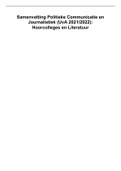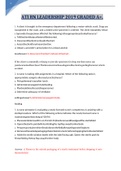Samenvatting Politieke Communicatie en
Journalistiek (UvA 2021/2022):
Hoorcolleges en Literatuur
,Samenvatting Politieke Communicatie (2021/2022)
Hoorcolleges + literatuur week 1 t/m 7
Alle opgenomen literatuur:
Week 1: Inleiding PC&J + basisconcepten
- Het inleidende hoofdstuk van: Bennett, W. L. (2016). News: The politics of illusion.
University of Chicago Press.
- Strömbäck, J. (2008). Four phases of mediatization: An analysis of the mediatization of
politics. The International Journal of Press/Politics, 13, 228-246
- Plessing, J. (2017). Shifting the South African media diversity debate from the stick to the
carrot: lessons from Scandinavia, Latin America and West Africa. African Journalism Studies,
38(1), 66-84.
Week 2: Protest en politieke participatie
- Wouters, R. (2013). From the street to the screen: Characteristics of protest events as
determinants of television news coverage. Mobilization: An International Quarterly, 18(1),
83-105.
- Valenzuela, S., Correa, T., & Gil De Zúñiga, H. (2017). Ties, Likes, and Tweets: Using Strong
and Weak Ties to Explain Differences in Protest Participation Across Facebook and Twitter
Use. Political Communication, 35(1), 117–134.
https://doi.org/10.1080/10584609.2017.1334726
- Harlow, S., Kilgo, D. K., Salaverría, R., & García-Perdomo, V. (2020). Is the Whole World
Watching? Building a Typology of Protest Coverage on Social Media From Around the
World. Journalism Studies, 1-19.
Week 3: Personalisering en infotainment
- Van Aelst, P., Sheafer, T., & Stanyer, J. (2012). The personalization of mediated political
communication: A review of concepts, operationalizations and key findings. Journalism,
13(2), 203-220.
- Boukes, M. & Boomgaarden, H. G. (2016). Politician seeking voter: How interviews on feel-
good talk shows affect trust in politicians. International Journal of Communication, 10, 1145–
1166. Retrievable from
- Boukes, M. (2019). Agenda-setting with satire: How political satire increased TTIP’s saliency
on the public, media, and political agenda. Political Communication, 36, 426- 451.
Week 4: Populisme
- Bos, L., Schemer, C., Corbu, N., Hameleers, M., Andreadis, I., Schulz, A., ... & Fawzi, N.
(2020). The effects of populism as a social identity frame on persuasion and mobilisation:
Evidence from a 15‐country experiment. European Journal of Political Research, 59(1), 3-24.
- Hameleers, M. (2020). Augmenting polarization via social media? A comparative analysis of
Trump’s and Wilders’ online populist communication and the electorate’s interpretations
surrounding the elections. Acta Politica, 55(3), 331-350.
Week 5: Media & Politiek: politieke agendasetting
- Van Aelst, P., & Vliegenthart, R. (2014). Studying the tango: An analysis of parliamentary
questions and press coverage in the Netherlands. Journalism Studies, 15(4), 392-410.
, - Sevenans, J. (2017). The media’s informational function in political agendasetting processes.
The International Journal of Press/Politics, 22(2), 223-243.
Week 6: Internationale journalistiek
- Galtung, J. (2003). Peace journalism. Media Asia, 30(3), 177-180.
- Wright, K., Scott, M., & Bunce, M. (2020). Soft power, hard news: How journalists at
state-funded transnational media legitimize their work. The International Journal of
Press/Politics, 1940161220922832.
- Mitchelstein, E., & Boczkowski, P. J. (2021). What a Special Issue on Latin America
Teaches Us about Some Key Limitations in the Field of Digital Journalism. Digital
Journalism, 130-135.
Week 7: Future challenges
- Van Aelst, P., Strömbäck, J., Aalberg, T., Esser, F., De Vreese, C., Matthes, J., ... &
Stanyer, J. (2017). Political communication in a high-choice media environment: a
challenge for democracy?. Annals of the International Communication Association,
41(1), 3-27.
- Lewis, S. C. (2018). Lack of trust in the news media, institutional weakness, and
relational journalism as a potential way forward. Journalism, 21(3), 345–348.
https://doi.org/10.1177/1464884918807597
, Week 1: Inleiding PC&J + basisconcepten
Wat is politieke communicatie?
Politieke communicatie: interacties tussen politiek, media en het
publiek
- Politiek: maakt het beleid
- Publiek: kiezen politieke actoren en ondergaan het beleid
- Media: spelen een rol tussen politiek en publiek
Het gaat dus om de relaties tussen politieke actoren, media/journalisten en burgers
Vaak is de vraag: wie geeft richting aan deze relaties? Wie controleert wie?
Focus op krachtsverhoudingen
Wat verwachten we van de media?
In een democratie zien we de media als (vrije) vierde macht
Functies van de media in een (ideale) democratie (McNair, 2011):
1. Informatie: monitoring, informeren van het publiek
2. Educatie: uitleggen wat feiten en events betekenen en waarom het belangrijk is
3. Platform functie: media moeten dienen als een virtuele plaats waar ideeen
uitgewisseld kunnen worden. Er komen verschillende standpunten met elkaar in
contact, waaronder afwijkende meningen. Media zijn een goede plek om verschillende
actoren hun mening te laten uiten.
4. Waakhond functie: controle en rapportering over wat de overheid ( of bedrijven)
doet. Media moeten het publiek informeren als er iets misgaat in de politiek. Dit is een
functie die vaak onder druk staat, maar wel heel belangrijk is: iemand moet politici
controleren en dingen naar buiten brengen als er iets fout gaat.
5. Kanaal functie: media dienen als kanaal verschillende politieke boodschappen en
meningen aan bod te laten komen. Kiezers moeten weten waar politieke partijen voor
staan.
Dit zijn functies in het algemeen en worden niet door alle media allemaal opgenomen.
Hoe zien journalisten hun werk dan?
Journalistieke rolopvattingen (David Weaver):
1. Disseminator: informatieverspreiding
2. Interpreter: uitleggen en duiden wat de informatie betekent (gelinkt aan educatie
functie)
3. Adversarial: zich zeer kritisch opstellen tegenover politici en bedrijven (gelinkt aan
waakhond functie)
4. Populist mobilizer: probeert mensen mee te krijgen, engagement. Er wordt actief op
zoek gegaan naar meningen ene verhalen om ervoor te zorgen dat bepaalde meningen
aan bod komen van mensen die normaal niet zelf hun boodschap zouden brengen
(gelinkt aan platform functie)





